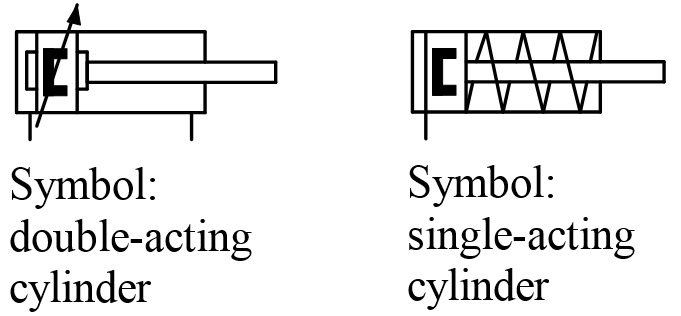English
Deutsch
Português
Español
- Pneumatics
- Pneumatic circuit diagrams
- Basic laws
- Celcius and Kelvin
- Compressed air – generation and treatment
- Pneumatic cylinders
- Pneumatic Way Valves
- Throttle valves
- Logic valves
- Pilot operated check valve
- Time function
- Quick Exhaust Valve
- Pressure Control Switch
- Pneumatic-motor
- Sequence control
- Work order
- Videos about pneumatics
- Index
Home ⇒ Overview Courses ⇒ Pneumatics ⇒ Cylinder
Selecting and calculating cylinder
- 0:00 Introduction
- 0:26 Overview of the most common cylinder types
- 0:38 Double acting cylinder
- 3:18 Double acting vs single-acting cylinder
- 4:40 Rodless cylinder (magnetic coupling, band cylinder, cable cylinder)
- 7:23 Telescoping cylinder
- 8:07 Rotary cylinder (Rack-and-pinion cylinders, vane cylinders)

pneumatic cylinder symbol
Cylinder characteristics are design, fixing method, dimension (diameter, stroke), air consumption - just to name a few examples. The design is determined by the type and the place of application.
Roughly you can distinguish two different cylinder types:
Double-acting cylinder can create a piston force in both directions; single-acting cylinder only in one direction.
The following figure illustrates the function of a double-action and a single-acting cylinder:

Pneumatics - Comparison Single-acting cylinder with double-acting cylinder
The double-acting cylinder has two working ports and can therefore create a force during extending and retracting the piston (hence the naming). The single-acting cylinders, however, can produce a force in one direction only. The retraction is done here by a return spring.
The single-acting cylinder has a significantly worse efficiency simply because the piston force has to work against the return spring. The efficiency is usually indicated on the data sheet of the cylinder. In this script we want, unless otherwise specified, assume an efficiency of 0.95 for double-acting cylinders and 0.8 for single-acting cylinders.
Due to the reset spring, the piston stroke is limited. Single-acting cylinders are offered up to a stroke of approx. 100 mm.
Furthermore single-acting cylinders spoil much faster because air from the environment enters into the cylinder body while retracting. The advantage for the simple-acting cylinders lies in the lower air consumption because the return spring retracts this cylinder automatically.
Single-acting cylinders are offered in two versions:

Single-acting cylinder normally extended
Single-acting cylinder normally retracted
Application: Pressing, punching, sorting, etc.
![]() Single-acting cylinder normally extended
Single-acting cylinder normally extended
Application: Lock, stopper for assembly line, gripper, etc.

